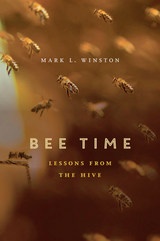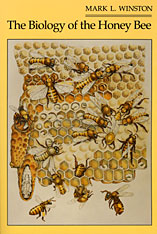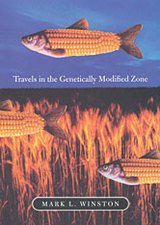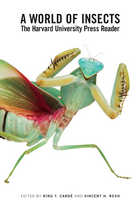
Being among bees is a full-body experience, Mark Winston writes—from the low hum of tens of thousands of insects and the pungent smell of honey and beeswax, to the sight of workers flying back and forth between flowers and the hive. The experience of an apiary slows our sense of time, heightens our awareness, and inspires awe. Bee Time presents Winston’s reflections on three decades spent studying these creatures, and on the lessons they can teach about how humans might better interact with one another and the natural world.
Like us, honeybees represent a pinnacle of animal sociality. How they submerge individual needs into the colony collective provides a lens through which to ponder human societies. Winston explains how bees process information, structure work, and communicate, and examines how corporate boardrooms are using bee societies as a model to improve collaboration. He investigates how bees have altered our understanding of agricultural ecosystems and how urban planners are looking to bees in designing more nature-friendly cities.
The relationship between bees and people has not always been benign. Bee populations are diminishing due to human impact, and we cannot afford to ignore what the demise of bees tells us about our own tenuous affiliation with nature. Toxic interactions between pesticides and bee diseases have been particularly harmful, foreshadowing similar effects of pesticides on human health. There is much to learn from bees in how they respond to these challenges. In sustaining their societies, bees teach us ways to sustain our own.

From ancient cave paintings of honey bee nests to modern science’s richly diversified investigation of honey bee biology and its applications, the human imagination has long been captivated by the mysterious and highly sophisticated behavior of this paragon among insect societies. In the first broad treatment of honey bee biology to appear in decades, Mark Winston provides rare access to the world of this extraordinary insect.
In a bright and engaging style, Winston probes the dynamics of the honey bee’s social organization. He recreates for us the complex infrastructure of the nest, describes the highly specialized behavior of workers, queens, and drones, and examines in detail the remarkable ability of the honey bee colony to regulate its functions according to events within and outside the nest. Winston integrates into his discussion the results of recent studies, bringing into sharp focus topics of current bee research. These include the exquisite architecture of the nest and its relation to bee physiology; the intricate division of labor and the relevance of a temporal caste structure to efficient functioning of the colony; and, finally, the life-death struggles of swarming, supersedure, and mating that mark the reproductive cycle of the honey bee.
The Biology of the Honey Bee not only reviews the basic aspects of social behavior, ecology, anatomy, physiology, and genetics, it also summarizes major controversies in contemporary honey bee research, such as the importance of kin recognition in the evolution of social behavior and the role of the well-known dance language in honey bee communication. Thorough, well-illustrated, and lucidly written, this book will for many years be a valuable resource for scholars, students, and beekeepers alike.


On our side, a vast arsenal of chemical pesticides. On their side? They don't have a side, the pests who must do nature's bidding. This is our war, and should we win it, ours would be a sorry planet. With disturbing news from the front, Nature Wars sounds the alarm against our dangerous tactics for controlling the pests that are an annoying but integral part of our world.
Thirty years after Silent Spring woke us to the devastation wrought by DDT, chemical pesticides are as pervasive as ever, deployed at a rate of 4 pounds a year for every man, woman, and child in this country. This ongoing commitment to pesticides, Mark Winston argues, reflects our sense of place in nature: embattled, beleaguered, driven to aggression. His book, as sensible as it is wise, seeks to change this mindset, to show how a more measured and discriminating approach to pests, one based on management rather than eradication, might serve us and the natural world far better than our ill-fated all-out war.
Winston backs up this approach with a full battery of case studies that take us from lawns and kitchens to farms and orchards, from insects and weeds to rats and coyotes. Here we see the complex political, biological, economic, social, and personal interactions that lie behind each pest management decision. Against this background Winston considers diverse instances of past pest management that reveal a consistent pattern of mistakes and problems--and lead to realistic, workable proposals for reducing pesticide use.
A compelling book about ethics and choices, Nature Wars shows us the difference between protecting ourselves from real pests and poisoning ourselves and the planet. It turns us from our war on nature to our task as stewards of the environment.

With genetically modified crops we have entered uncharted territory—where visions of the triumph of biotechnology in agriculture vie with dire views of medical and environmental disaster. For two years Mark L. Winston traveled this fraught territory at home and abroad, listening to farmers, industry spokespeople, regulators, and researchers, canvassing high-security laboratories, environmentalist enclaves, and cyberspace, making a thorough survey of the facts, opinions, and practices deployed by opponents and proponents of transgenic crops.
Through his sympathetic portrayal of the passions on all sides, Winston brings a clear, unbiased perspective to this bewildering landscape. Traveling with Winston, we see the excitement and curiosity that pervade laboratories developing genetically modified crops, as well as the panic and outrage among dedicated opponents of agricultural biotechnology; the desperation of conventional farmers as they look to science for solutions to the problems driving them from their farms, as well as the deeply held values of organic farmers who dread the incursion of genetically modified crops into their expanding enterprise. And, Winston shows us, these contrasting attitudes transcend national borders, with troubling counterparts and consequences in the developing world.
As he seeks a middle ground where concerns about genetic engineering can be rationally discussed and resolved, Winston gives us, at long last, a full and balanced view of the forces at play in the chaotic debate over agricultural biotechnology.

As we follow the path of a giant water bug or peer over the wing of a gypsy moth, we glimpse our world anew, at once shrunk and magnified. Owing to their size alone, insects’ experience of the world is radically different from ours. Air to them is as viscous as water to us. The predicament of size, along with the dizzying diversity of insects and their status as arguably the most successful organisms on earth, have inspired passion and eloquence in some of the world’s most innovative scientists. A World of Insects showcases classic works on insect behavior, physiology, and ecology published over half a century by Harvard University Press.
James Costa, Vincent Dethier, Thomas Eisner, Lee Goff, Bernd Heinrich, Bert Hölldobler, Kenneth Roeder, Andrew Ross, Thomas Seeley, Karl von Frisch, Gilbert Waldbauer, E. O. Wilson, and Mark Winston—each writer, in his unique voice, paints a close-up portrait of the ways insects explore their environment, outmaneuver their enemies, mate, and care for kin.
Selected by two world-class entomologists, these essays offer compelling descriptions of insect cooperation and warfare, the search for ancient insect DNA in amber, and the energy economics of hot-blooded insects. They also discuss the impact—for good and ill—of insects on our food supply, their role in crime scene investigation, and the popular fascination with pheromones, killer bees, and fire ants. Each entry begins with commentary on the authors, their topics, and the latest research in the field.
READERS
Browse our collection.
PUBLISHERS
See BiblioVault's publisher services.
STUDENT SERVICES
Files for college accessibility offices.
UChicago Accessibility Resources
home | accessibility | search | about | contact us
BiblioVault ® 2001 - 2025
The University of Chicago Press









